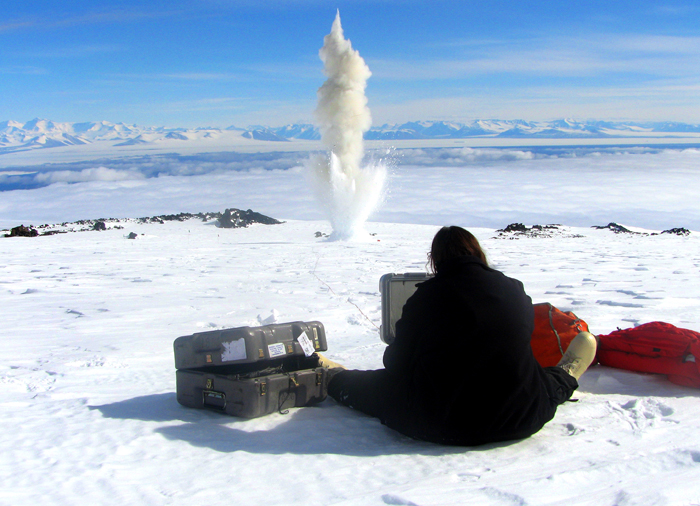
Photo Credit: Martin Reed |
Seismologist Catherine Snelson sets off small explosions on the flank of Mount Erebus to produce energy, or seismic waves, that instruments will measure and record. By studying the refracted and reflected waves, scientists can map the interior plumbing of the volcano. |
Plumbing Erebus
Scientists use seismic technique to map interior of Antarctic volcano
By Peter Rejcek, Antarctic Sun Editor
Posted February 22, 2008
To look deep inside an Antarctic volcano, scientist Phil Kyle and his team have to use a little force.
Researchers spent more than three months installing an array of seismometers around Mount Erebus to listen to waves of energy generated by small, controlled blasts from explosives they buried along its flanks and perimeter. Seismometers measure and record the size and force of underground energy, or seismic, waves.
By studying the refracted and reflected seismic waves, the scientists can map the interior of the volcano, much as a CT scan images the inside of an object using X-rays. Kyle, a volcanologist with the New Mexico Institute of Mining and Technology, has learned much about Erebus in the last 35 years. But so far, he only has suspicions of what lies below the magma lake, a pool of molten rock, visible from the crater rim.
“There have been very few direct studies of a volcano’s magma chamber,” Kyle said. “What you see in the textbooks — the long, straight conduit leading down to a round chamber — probably isn’t at all what it looks like.”
Instead, Kyle said, what probably exists is a conduit that leads down to a series of irregularly shaped chambers. He makes the point with a zigzag of his fingers.
This year’s goal to establish the seismic network and test the concept hasn’t been an easy one to reach. Atrocious weather often pinned down the people working on the 3,796-meter-high volcano and left helicopters on standby at McMurdo Station for days at a time.
Still, as the season came to a close at the end of January, the scientists had managed to install 23 of 25 planned broadband seismic stations around the flanks and summit that will stay out to record sound waves from distant earthquakes and the volcano’s own rumblings over the next year. In addition, the team set up 14 temporary sensors just to record the explosions, and later recovered those instruments.
Catherine Snelson, assistant professor of geophysics at New Mexico Institute of Mining and Technology, is in charge of the active-source seismic work. She and blasters from McMurdo Station had managed to set off seven blasts to start building an image in the upper 2 kilometers of the volcano, in what they hope will set the stage for a possible larger campaign in a coming field season.
“We’re going down about 21 kilometers,” Snelson said. “The emphasis this year is to develop the technique.”
(Environmental effects from the installation, operation and removal of the seismic instruments — in addition to the use of explosive charges on Mount Erebus — should be less than minor or transitory, according to an environmental review of the project prior to the beginning of the season. Following detonation, non-explosive residues are collected and transported to McMurdo Station for disposal as waste.)
The seismic waves recorded by the instruments after the explosions help the scientists infer where areas of heat and magma are located. Snelson said the velocity of the waves also says something about the types of rocks and liquids buried below.
Kyle emphasized that there was no danger of the explosives creating any sort of reaction in the volcano. “They’re like little earthquakes,” he said.
The process to create these little earthquakes isn’t too earth shattering, they said.
1 2 Next





